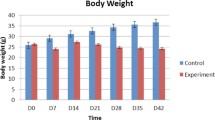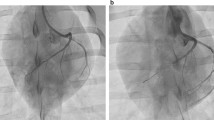Abstract
Clinically effective cardioprotection under acute myocardial infarction (AMI) can only be achieved by establishing the mechanisms of reperfusion-induced cardiac cell death. In spite of the numerous earlier studies on the prevention of ischemia–reperfusion injury of myocardium, the problem of cardiac cell death upon reperfusion is not yet resolved. Even though animal models provide an immense opportunity in the understanding of the mechanisms of ischemia–reperfusion injury, clinically relevant animal models through which translation of this knowledge into clinic are lacking. In this work, we have established a reperfusion model in rabbits with induced AMI by obstructing and releasing the left anterior ventricular branch of left circumflex coronary artery, which is clinically more relevant. This was achieved by cutting the two left ribs of the rabbit followed by obstructing and releasing the artery unlike the traditional approach, which involves incision through sternum and blocking the anterior descending coronary artery. This animal model of ischemia–reperfusion more closely mimics the physiological condition and also the trauma the animal suffers is much smaller with higher survival rate and thus is a potentially better model for studying the pathology related to ischemia–reperfusion injury.









Similar content being viewed by others
References
Mewton, N., Ivanes, F., Cour, M., & Ovize, M. (2010). Postconditioning: From experimental proof to clinical concept. Disease Models and Mechanisms, 3, 39–44.
McGovern, P. G., Pankow, J. S., Shahar, E., Doliszny, K. M., Folsom, A. R., et al. (1996). Recent trends in acute coronary heart disease—mortality, morbidity, medical care, and risk factors. The Minnesota Heart Survey Investigators. New England Journal of Medicine, 334, 884–890.
Yellon, D. M., & Hausenloy, D. J. (2007). Myocardial reperfusion injury. New England Journal of Medicine, 357, 1121–1135.
Reichek, N., & Parcham-Azad, K. (2010). Reperfusion injury putting the genie back in the bottle? Journal of the American College of Cardiology, 55, 1206–1208.
Piper, H. M., Abdallah, Y., & Schafer, C. (2004). The first minutes of reperfusion: A window of opportunity for cardioprotection. Cardiovascular Research, 61, 365–371.
Yang, X. M., Proctor, J. B., Cui, L., Krieg, T., Downey, J. M., et al. (2004). Multiple, brief coronary occlusions during early reperfusion protect rabbit hearts by targeting cell signaling pathways. Journal of the American College of Cardiology, 44, 1103–1110.
Bolli, R., Becker, L., Gross, G., Mentzer, R, Jr., Balshaw, D., et al. (2004). Myocardial protection at a crossroads: The need for translation into clinical therapy. Circulation Research, 95, 125–134.
Yang, X. M., Baxter, G. F., Heads, R. J., Yellon, D. M., Downey, J. M., et al. (1996). Infarct limitation of the second window of protection in a conscious rabbit model. Cardiovascular Research, 31, 777–783.
The-Editorial-Board. (2001). Guidelines for the diagnosis and management of Chinese patients with acute myocardial infarction. Chinese Journal of Cardiology (China), 29, 710–725.
The-Editorial-Board. (1991). Thrombolytic therapies in myocardial infarction. Chinese Journal of Cardiology (China), 19, 137.
Newman, D. J., Olabiran, Y., Bedzyk, W. D., Chance, S., Gorman, E. G., et al. (1999). Impact of antibody specificity and calibration material on the measure of agreement between methods for cardiac troponin I. Clinical Chemistry, 45, 822–828.
Levesque, A., Letellier, M., & Grant, A. (1997). Analytical evaluation of the CK-MB mass assay on the Technicon Immuno 1 system. Clinical Biochemistry, 30, 11–16.
Evans, G. O. (1991). Biochemical assessment of cardiac function and damage in animal species. A review of the current approach of the academic, governmental and industrial institutions represented by the Animal Clinical Chemistry Association. Journal of Applied Toxicology, 11, 15–21.
Keller, T., Zeller, T., Peetz, D., Tzikas, S., Roth, A., et al. (2009). Sensitive troponin I assay in early diagnosis of acute myocardial infarction. New England Journal of Medicine, 361, 868–877.
O’Brien, P. J., Landt, Y., & Ladenson, J. H. (1997). Differential reactivity of cardiac and skeletal muscle from various species in a cardiac troponin I immunoassay. Clinical Chemistry, 43, 2333–2338.
Jiang, Z. L., Harada, T., Kohzuki, M., Kamimoto, M., & Sato, T. (1996). Plasma enzymic changes in insulin-induced hypoglycemia in experimental rabbits. Tohoku Journal of Experimental Medicine, 179, 219–222.
van den Bos, E. J., Thompson, R. B., Wagner, A., Mahrholdt, H., Morimoto, Y., et al. (2005). Functional assessment of myoblast transplantation for cardiac repair with magnetic resonance imaging. European Journal of Heart Failure, 7, 435–443.
Hoshida, S., Yamashita, N., Kawahara, K., Kuzuya, T., & Hori, M. (1999). Amelioration by quinapril of myocardial infarction induced by coronary occlusion/reperfusion in a rabbit model of atherosclerosis: Possible mechanisms. Circulation, 99, 434–440.
Zhou, S. N., Shao, J. H., & Lu, X. Y. (2003). A rabbit model with myocardial ischemia reperfusion injury and its protection with astragalus injection plus lignstrazine. Chinese Journal of Integrative Medcine on Cardio/Cerebrovascular Disease, 1, 649–650.
Author information
Authors and Affiliations
Corresponding author
Rights and permissions
About this article
Cite this article
Zhang, J., Qi, XY., Wan, YF. et al. Establishment of a Reperfusion Model in Rabbits with Acute Myocardial Infarction. Cell Biochem Biophys 60, 249–258 (2011). https://doi.org/10.1007/s12013-010-9147-3
Published:
Issue Date:
DOI: https://doi.org/10.1007/s12013-010-9147-3




